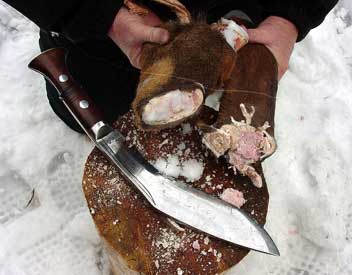Cleaving with a Khukuri
Ron Hood
1/24/2000©
This article appeared in Tactical Knives Magazine

I’ve always been a fan of big blades. In my line of work as a survival instructor/wilderness video producer I spend a lot of my time chopping, shaping and carving wood and bone. During the 30 years I’ve been doing this sort of thing, I’ve learned that you can use a big knife to do a small job but you can’t use a small knife to do a big job. The khukuri is the epitome of a big blade.
I’ve played with khukuri style blades for years. I like the drop of the blade, and the big sweet spot in the belly. Years ago, a good friend of mine, the late Martin Kruse, hammer forged a Khukuri style blade for me. I used it for years as my primary chopper. I always wondered how the actual blades would stand up to my style of use but I shied away because I could never find a native Khukuri that said anything but “Cheap” that is until I heard about Gurkha House.
Recently I received two of the real khukuris from Craig Gottlieb of Gurkha House for testing and review. These blades were a far cry from the junk I’d seen on sale at gun shows and shops. The two blades both showed the basic design elements of the traditional Khukuri. The big curved blade, the traditional notch at the base of the blade and the beefy construction real Khukuris are known for. One of the blades sported a full exposed tang with rosewood handle slabs while the other appeared to use a spike tang construction in a waterbuffalo horn handle.
One of the things I’ve wondered about is the function of the notch found at the base of the blade. I’ve heard all sorts of stories so I thought I’d better check with Craig. He informed me that the cut out is called the "Cho”. He said that it appears on all khukuris, and that it represents Shiva the Hindu God (and the God of War) that governs destruction and transcendence. The deity is usually shown holding a trident in one hand. The crescent-shaped cutout on all khukuris represents Shiva’s trident. It also explains the function the blade is intended to fulfill. This is a warblade.
Before I went to work whacking, chopping and splitting, I wanted to get some hardness numbers. I sent the blades off to SCK in Clancy Montana for a quick RC test. These blades are forged from truck springs, heated in a fire and tempered with a tea kettle. My thought was that control over the tempering process might be a little spotty. I was wrong.
It turned out that the blades were differentially tempered surprisingly well. The spine on the blades read 22 and 25 RC respectively. The mid point of the belly measured in at 45 and 46 RC and the edge came in at 54 and 55RC, not bad for some guy squatting around a fire in sandals! The numbers also showed that these blades are soft enough to take some serious abuse and keep a tolerable edge. My bet was that whoever made these blades has a lot of experience under their belt.
Each of the blades was slightly different in construction. One model, the Panawal, is a rougher “work horse” model with pinned handle slabs and the other the “Bhojpure” had a finer fit and finish. Both blades featured sheaths made of wood wrapped in waterbuffalo skin. They both came with the traditional Chakma (the dull flint-maker and crude sharpener) and the Charda the sharper utility mini-knife.
|
Model |
OAL: |
Blade: |
Spine: |
Handle: |
Weight: |
|
Bhojpure |
16 in |
10.5 in |
3/8 in |
Buffalo horn |
19.3 oz |
|
Panawal |
15.5 |
10 |
1/2 in |
Rosewood |
26 oz |
While my overall impression of the big blades was good, the smaller knives looked crude and rough in design and finish. None of the smaller blades had a sharp edge and one-showed signs of having been burned on the grinding wheel.
I decided to use the heavier blade for my testing. I wanted to give that heavy Panawal a chance to go to war with one of the many Ponderosa pines that choke my land. We loaded up the camera, the snowmobile, a first aid kit, and the cooler (to keep the refreshments warm) and went out in search of a vertical victim.
There is a lot of young growth timber on the land so I selected a likely candidate for next years kindling and went to work. The tree had a cross section of just over 6 inches. I laid into the cold green wood with vigor and after about twenty hard whacks I had less vigor and a nice sized chunk missing from the tree. Twenty more whacks had it leaning and another ten dropped it. After fifty whacks and a sore arm I checked out the blade. The edge seemed to be about the same as when I started.
During the following two hours I whacked on green limbs, dead branches, old downed timber and fresh snow kill. My final impression, this blade is a chopping demon. But like all demons it can bite you. The dramatic drop on the blade can cause the knife to twist in your hand upon contact, this twist then gets translated to “get the hell out of the way” energy. If you get tired while using a khukuri, stop using it until you are rested. It didn’t bite me but I can see that it has the potential to be a real shin slicer.
OK…so the thing can chop wood like a chain saw but isn’t this supposed to be a war blade? A blade designed to chop off the limbs of enemies, to remove the heads from buffalo? I have a very special test for blades that claim to be tactical choppers…. bone chopping.
I’ve conducted this test on a number of blades in the past. I use a fresh Elk leg as the target (PETA types… the Elk is dead). Over the time I’ve used the test I’ve learned that it is a great way to create a serrated blade. The impact of steel with heavy bone has a special property that seems to break chunks out of all but the most stalwart choppers. You can’t be light in the loafers when you whack a bone, you’ve got get your wrist into it (now where have you heard THAT before?).
Having started bone whacking in adolescence I confidently confronted the bone and went to work. It only took about 15 whacks to cut through the tough bone, sinew and muscle of the leg. Wow! This thing can cut… I looked at the blade. I now had a serrated Khukuri.
When I looked at the edge under magnification I could see that some very small pieces had broken off but the majority of the nicks were just places where the metal had indented under the impact. Ten minutes with a belt sander or some time with a steel should bring this baby back… but I was finished.
Some other points.
The brass tipped sheaths are functional and do a good job holding the blades securely. I noticed that after the testing the leather had become wet and one of my dogs was strangely attracted to it. A day later I too was able to smell the attractant. Roadkill would be my description. The belt loop is secured to a strap of leather that is compression fitted to the sheath. This affair soon loosened and the sheath and belt loop parted ways. If I were going to carry one of these big blades I would buy or fashion a secure Kydex sheath for the knife and keep the native sheath for display.
The blade stood up to some severely destructive tests. There was no edge deviation or distortion with standard chopping tests. In fact the edge retention was very good even on the harder knots and dry woods. The bone chop test is severe and some failure is to be expected.
If you are looking for a big mean chopper that can denude a mountainside and get it for the right price… this is your baby.
Gurkha House
Craig Gottlieb
www.cystern.com
(703) 536-5555
SCK
www.simonichknives.com
Box 278, Clancy MT 59634
(406) 933-9151












